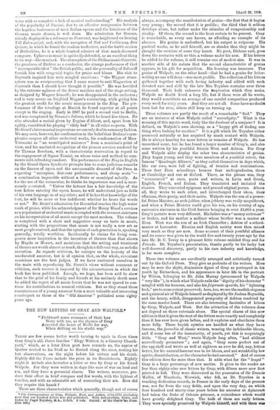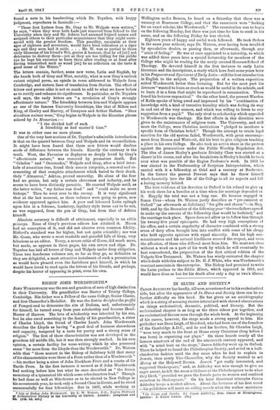THE NEW LETTERS OF GRAY AND WALPOLE.* " Fieldward some
remnants of their lore Went with me, as the rhymes of Gray Annealed the heart of Wolfe for war, When drifting on his starlit way."
THERE are few poems better worth turning to again in these times than Gray's old, thrice familiar "Elegy Written in a Country Church- yard," which, as a later Eton poet here reminds us, the captor of Quebec recited to his Staff as ho floated along the river, making his last observations, on the night before his victory and his death. Rightly did the Times include the piece in its Broadsheets. Rightly might it include also hereafter a letter or two by Gray or his friend Walpole. For they were written in days like ours of war on land and sea, and they have a perennial charm. The writers, moreover, pro- duce their effect in brief compass and few words, with the lightest of touches, and with an admirable art of concealing their art. How did they acquire this knack ?
There are three characteristics which generally, though not of course
• The Correspondence vf Gray, Walpole, West, and Ashton, 1734-1771 (inciuding snore than one hundred Letters now first published). With Introduction, Notes, and Index by Paget Toynbee,, ALA.. D.Litt. 2 vols. Oxford: at the ClarearNon Press.
.• Ills. ast.1 •
always, accompany the manifestation of genius—the first that it begins very young ; the second that it is prolific ; the third that it seldom develops alone, but rather under the stimulus of companionship and rivalry. Of these, the second is the least certain to be present. Gray is remarkable, as every one knows, as affording an example of its absence. His genius is undoubted, but his output is exiguous. His poetical works, as he said himself, are so slender that they might be thought the creation of some tiny insect. No poet, Dickens said, goes down the centuries with so thin a volume under his arm. If his letters be added to the volume, it still remains one of modest size. It was in another side of his nature that the second characteristic of genius appears, in his gift for acquisition. His learning was immense. The genius of Walpole, on the other hand—that he had a genius for letter. writing no one will deny—was most prolific. The collection of his letters gathered together with such loving industry and edited with such devoted care and shill by the late Mrs. Toynbea contains over three thousand. Their bulk enhances the impression which they make. Walpole no doubt lived a long life, but if those were all he wrote, they would constitute an average of one careful composition produced every week for sixty years. And they are not all. Some have no doubt been lost for ever, others still keep on turning up.
These volumes are partly the result of a remarkable "find." They are an instance of what Walpole called "serendipity." What is the meaning of this mystic word, truly like the ducdame of a conjuror? It is defined, on Walpole's own showing, as a "happy gift of finding one thing when looking for another." It is a gift which Dr. Toynbee either possessed naturally or has acquired by much contact with Walpole. Ho is always hunting for more letters or remains of Walpole. He has unearthed some, but he has found a larger number of Gray's, and also some written by his youthful friends West and Ashton. For Gray and Walpole alike display the other two characteristics of genius. 7hey began young, and they were members of a youthful coterie, the famous " Quadruple Alliance," as they called themselves in days which, like our own, were full of fighting, of treaties and combinations. These four Eton schoolboys became four undergraduates, three at Cambridge and one at Oxford. There, as the phrase was, they " commenced " at once, poets and writers, in Latin and Greek, English, French, and Italian. They translated and imitated the classics. They concocted epigrams and penned original poems. Above all, they wrote to each other, and interchanged their ideas, theis effusions, their gossip, and their satire. Walpole was the son of a power- ful Prime Minister, an arch-jobber, when jobbery was really magnificent., and when a Prime Minister could give his son, on his coming of age, successive sinecures in tho Civil Service bringing in over £1,000 a year. Gray's parents were very different. His father was a "money scrivener" or broker, and his mother a milliner whose brother was a master at Eton. West was the son of an Irish Chancellor ; Ashton of a school- master at Lancaster. Etonian and English society were than mixed very much as they are now. Some account of their youthful alliance and its course was given to the world five-and-twenty years ago by the late Mr. D. C. Tovey in a pleasant little volume entitled Gray and his Friends. Dr. Toynbee's presentation, thanks partly to his lucky but well-deserved discovery, partly to his rare industry and knowledge, is far more complete.
These two volumes are excellently arranged and artistically turned out by the Oxford Press. They give us portraits of the writers. Here may be seen the slight, diminutive figure of Gray as portrayed in his youth by Richardson, and his appearance in later life in the portrait by Wilson, belonging to Mr. John Murray (pronounced by Walpole "very like "), in which what Walpole calls the" dignity of his character" mingled with his humour, and also his folgorarde sguardo, his "lightning look," are to some extent preserved; here, too, we see the modish elegance and quizzical air of Walpole himself as displayed by Sir Joshua Reynolds, and the heavy, selfish, disappointed pomposity of Ashton rendered by the same master-hand. There are also interesting facsimiles of letters by Gray, Walpole, and West. But the attraction of the volumes does not depend on these externals alone. The special charm of this new edition is that it gives the text of the letters more exactly and completely than it has ever been given before, and it explains and elucidates thorn more fully. These boyish epistles are handled as what they have become, the juvenilia of classic writers, wearing the indefinable bloom, and if some too of the immaturity, of youth, yet this is surprisingly little. "Gray and West," wrote Walpole long after, "had abilities marvellously premature " ; and again, "Gray came perfect out of the egg-shell and wrote as well at eighteen as ever he did, nay, letters better, for his natural humour was in its bloom, and not wrinkled by low spirits, dissatisfaction, or the character he had assumed." And of course this edition does far more than that. It adds what for the " frugal " Gray is a large percentage of new matter. It gives to the reader no less than eighty-nine new letters by Gray, with fifteen more now first printed in full. They were discovered in the possession of Sir Francis Waller, of Woodcote, Warwick, who fell, as Dr. Toynbee in a touching dedication records, in France in the early days of the present war, not far from the very fields, and upon the very day, on which four hundred and ninety-nine years before his ancestor at Agincourt had taken the Duke of Orleans prisoner, a coincidence which would have greatly delighted Gray. The bulk of them are early letters. They were specially preserved by Walpole himself, and with them was
found a note in his handwriting -which Dr. Toynbee, with happy judgment, reproduces in facsimile -- "These first Letters from Mr. Gray to Mr. Walpole were written," he says, "when they were both Lads just removed from School to the University when they and Mr. Ashton had assumed feigned names and assigned others to their particular acquaintance that they might corre- spond with the greater freedom. This puerility, excusable at their ages of eighteen and seventeen, would have been ridiculous at a riper ago and they soon laid it aside. . . . Mr. W. was so partial to those early blossoms of his friend's Wit, genius & humour, that he cd [sic] not determine to destroy them—yet as they are too trifling for the public eye he begs his executor to burn them after reading or at least after having transcribed such as woud [sic] be no reflection on the taste & good sense of the Writer."
The letters contain, further, some new verse, Latin and English, by the hands both of Gray and West, notably, what is now Gray's earliest extant original poem, an epistle in verso addressed to Walpole from Cambridge, and sixteen lines of translation from Stating. The effect of letters and poems alike is not so much to add to what we knew before as to rectify and enhance its significance. In particular, as Dr. Toynbee well says, the early letters are "a revelation of Gray's strongly affectionate nature." The friendship between him and Walpole appears as one of the famous University friendships, like that of Milton and King, of Cowley and Harvey, of Tennyson and Arthur Hallam. "Dear dimidium animae niece," Gray begins to Walpole in the Horatian phrase echoed by In Memoriam :— "I the divided half of such
A friendship as had master'd time." It was in either case no mere phrase.
One of the very best sections of Dr. Toynbee's admirable introduction Is that on the quarrel between Gray and Walpole and its reconciliation. It might have been feared that these new letters would disclose seeds of difference between the friends. Exactly the contrary is the truth. West, the Favonius or Zephyrus so deeply loved by Gray's "affectionate nature," was removed by premature death. But " Celadon " and " Orosmades," Walpole and Gray, after a brief inter- lude of amantium iro,e, found their anions integratio, a renewal and re- cementing of that complete attachment which lasted to their death. Only " Almanzor," .Ashton, proved unworthy. He alone of the four had no genius, but only a certain cleverness and industry, and he seems to have been distinctly parasitic. Ho courted Walpole until, as the latter writes, "my father was dead" and "could make no more bishops." Then he went over to the enemy. It is very significant that at the last moment, as these volumes were going to press, new evidence appeared against him. A poor and laboured Latin epitaph upon him in a fulsome, laudatory, lapidary style turns out to be not, as was supposed, from the pen of Gray, but from that of Ashton himself.
Absolute accuracy is difficult of attainment, especially in an editio princeps. None of Gray's previous editors has attained it. Mason had no conception of it, and did not observe even common fidelity. Ilitford's standard was far higher, but not quite scientific ; nor was Mr. Gosse, who wrote a most readable and graceful Life of Gray, very laborious as an editor. Tovey, a severe critic of Gosse, did much more, but made, as appears in these pages, his own errors and slips. Dr. Toynbee has laid all lovers of Gray and Walpole under deep obligation. These two handsome volumes are, so far as they go, as definitive as they are delightful, a most attractive instalment of such a presentation as would have pleased even the fastidious poct himself, in which he would have loved to read again the letters of his friends, and perhaps, despite his horror of appearing in print, even his own.



























 Previous page
Previous page